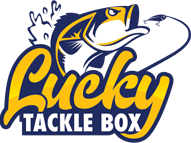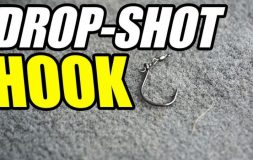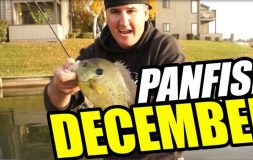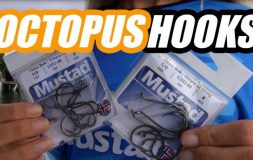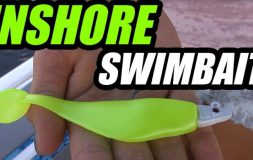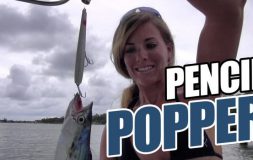Best spring fishing tips: Top 5 things you need to know to catch your new PB
Spring is finally here, and your next “personal best” catch is waiting for you! Without a doubt, spring is one of the most productive, exciting seasons of fishing. Not only are there plenty of bass to catch, but they’re big and fat from a long winter of feeding.
It doesn’t matter if you’re fishing from a boat, a kayak, or from the shore – if you have the right tools, tips, and techniques in your tackle box, you can maximize your LUCK in high percentage areas! In Travis Moran’s latest Lucky Tackle Box video, he breaks down the FIVE top tips you need to know to master spring fishing.
So press play, take notes, and get ready to update your profile pic on Facebook and Instagram. Because trust us, you’re gonna want to show off your next catch!
- 1) Three Key Phases Of Spring
Spring can be broken into three key phases: Pre-Spawn, Spawn & Post-Spawn. Understanding each phase will help you locate the right fish and select the right lures so you can catch bigger, better, “personal best” bass! You can usually tell which phase you’re in based on water temperature. Pre-Spawn occurs when the water reaches 45-50 degrees, Spawn from 55-70 degrees, and Post-Spawn from 70 degrees and above. However, it’s important to remember that not all bass go through each phase at the same time, so you’ve got to rely on other clues if you want to pattern fish effectively.
- 2) Location, Location, Location!
As the water warms up, bass begin their migration to spawn, moving from deep waters to shallow banks that get a lot of sun. Having success is all about identifying key spots on that journey so you can intercept the fish on their route! It’s essential to also identify areas of the lake that are ideal for spawning. Fish like a hard bottom that’s protected from the elements like wind and current, and they also need exposure to plenty of sunlight to incubate their eggs. Ideal areas tend to be in shallow water, but they can vary depending on the body of water and also the species of bass you’re fishing.
- 3) Pay Attention To The Environment
Water clarity is a big deal because as we know, bass need sunlight to incubate their eggs. Basically, in dirty water fish will spawn shallow, and in clean water fish will spawn deeper. Look specifically at northern and western banks, which tend to get a lot of sun during the spring, which warms up the water faster and causes the bass to go into their spawning mode earlier. In addition to dirty water and sun exposure, also watch for wind. Bass will avoid spawning on banks that get continuously blown out, since the water sediment affects sun exposure and can even kill the eggs altogether.
- 4) Not All Bass Are Equal
The three most common types of bass are largemouth bass, smallmouth bass, and spotted bass. All three species go through the spawning cycle during the spring, but each have some unique differences. Largemouth bass love to spawn shallow, when water temps reach 60-70 degrees. Smallmouth bass tend to love clear, deeper water – about 3-15 feet deep. Spotted bass are hardy fish, and they don’t mind the cold water, so feel free to go deep if they’re your jam! The point is, don’t typecast bass – take time to learn about the characteristics of each species, and then wow your buddies with your newfound knowledge!
- 5) Lure Selection Is Key
We’re Lucky Tackle Box – did you think we were gonna forget about the importance of lures?! Bass are extremely aggressive during the spring and will strike a wide variety of baits. Be sure you have baits that cover all the water columns – top, middle, and bottom. A few staples to always keep in your tackle box are: a jerkbait, jig bait, buzz bait, poppers, frogs, and plastics! Although there’s no “magic lure” that will guarantee a good catch, the more knowledge you have, the better your chances will be! It’s important to consider the body of water you’re on, identify high percentage areas based on if it’s Pre-Spawn, Spawn, or Post-Spawn, and then select a lure that will effectively fish that lake.
That’s it, guys – we hope that information was helpful! And remember, fishing in the spring is a blast no matter what skill level you’re at, and there is ALWAYS room for improvement.
Did you learn something new? Let us know in the comments below! And as always, if you catch your new PB by implementing Lucky Tackle Box tips, give us a shout out on social media.
Until next time… tight lines!
+++
Best Spring Fishing Tips: Travis Moran Video Transcription
Spring is finally here, and your next fishing trip could be the most exciting of the entire year. Not only in numbers of bass, but opportunities at some of the biggest bass out there. So you can update your profile pics on Instagram, Facebook, and have bragging rights over your buddies for the rest of the season. I don’t care if you’re fishing from a boat, a kayak, or you’re hooking it old school along the shore, if you understand what these fish are up to this time of the year, you can maximize your time in high percentage areas with the right lures. So I put together five general keys to fish this spring to help you maximize your time out on the water and get you one step closer to catching your personal best.
(00:40)
Number one, three phases; spring can be broken up into pre-spawn, spawn, and post-spawn. As the weather gets better and we come out of wintertime, those water temps are going to get up to about the high 40s, mid 50s, and these bass are going to go into their pre-spawn mode. They’re going to leave their cold water hangouts and start moving towards the shallower areas where they’re eventually going to spawn. In between these two spots is where they start feeding up heavily. This can be some of the best bass fishing of the entire year because these bass need to fatten up in a hurry before they move up shallow to spawn.
(01:16)
Now as water temps hit between 55 and about 70 degrees, the male bass will move up into the spawning areas and start building the nests. And then the females will follow shortly after to lay the eggs. Now bass during this time are not really keyed into feeding. That’s why they fed up so much in the pre-spawn. But they are extremely aggressive and extremely territorial this year, so they’ll still strike lures, and this can make for some really exciting shallow water fishing.
(01:43)
Post-spawn. Once water temps hit about 70 degrees and above, the majority of bass are finishing up spawning and heading out to deeper, cooler summertime hangouts. This starts with the female bass. Shortly after they lay their eggs, they begin to head out to deeper water to recover, leaving the males still up shallow to guard the eggs. And then once they hatch, they’ll fry for another week or so, and then they’ll head out to deeper water as well. Now these fish get totally beat up and fatigued during the spawn, so they don’t feed nearly as aggressively as they did during the pre-spawn. However, they still do feed very heavily, but it’s just in shorter, concise bite windows. So understanding those different windows, you can really maximize your catches this time.
(02:27)
All right, guys, pre-spawn, spawn, post-spawn. Sounds pretty simple, right? Now let’s mix things up with some little grayish details. All the bass do not go through all these phases at the same time. For example, on any given body of water, one end of the lake, the fish can be up shallow in the full spawn mode, where the other end of the lake, the fish can be just starting to go into their pre-spawn feeding mode. It depends on the varying conditions throughout the lake that dictate what phase these fish are going to be in.
(02:54)
Lastly, not all the fish in a given area are going to move up all at once. They tend to do so in waves during ideal conditions over the course of months. Understanding the three phases of spring will not only help you locate the fish, but it’ll aid in helping you select the right lures that are going to get those bass to strike.
(03:12)
Number two, location. Okay, so we’ve already established as the water warms up, the bass begin their migrations to spawn. Having success this time of the year is all about identifying key stops along this journey, where you can intercept the fish as they feed up for the spawn. The best way of doing this is by first identifying where these fish are going to end up to spawn. Then back up and figure out where they’re going to be coming from out of their cold wintertime hangouts. Once you have the beginning and the end of their journey, you can better identify key areas along that route that those fish are going to be using.
(03:49)
Now let’s talk real quick about what these fish need to spawn. They need hard bottom that’s protected from the elements like wind and current. And then they need exposure to plenty of sunlight to incubate those eggs. These areas tend to be in shallower water, but can vary depending on the body of water and also the species of bass.
(04:07)
So now let’s take a look at an easy example of a spawning migration in a creek arm. The small coves and cuts in the back of the creek are shallow, therefore warmer, and are protected from the wind and other elements, so these will be ideal areas for bass to eventually spawn. Now in the winter, the bigger concentrations of the bass were oriented more towards the main lake on big points or steep bluffs that offer deep water access. We now have our two points and can begin identifying possible hot spots for these bass as they move into the creek arm.
(04:42)
Now at this point, you want to just focus on that fishy looking structure and coverage as you work your way back into the arm. This can be secondary points, island humps, laid down trees, and bends in the creek channel. Fish will group up in key areas and feed like crazy, making it a great time to catch a lot of bass. This is that pre-spawn period that these fish are near their spawning areas, but they’re fattening up, waiting for those perfect conditions to move up and spawn. As these fish gorge themselves, eventually the mood will be right and a wave of bass will move up to spawn. Once they’re done, they’ll actually move back out and disperse among a lot of those areas that they used during the pre-spawn, as well as out in the main lake, where they’re going to recover and chillax for the rest of the summer.
(05:30)
Number three, environmental variables. We’ve now discussed that warming waters push these fish along their migration routes towards their spawning areas. But now let’s take a look at some other variables. Water clarity is a big deal. Bass need the sunlight to incubate their eggs. Stained water prevents deeper light penetration, so the bass will tend to spawn shallower in these conditions. Basically, in dirtier water, fish are going to spawn shallower. And conversely, in cleaner water, bass are going to spawn deeper. Another point with sunlight to take note of is which banks on a body of water are getting more of it. Northern and western banks tend to have sun shining on them longer this time of the year, warming them up faster, causing the bass to go into their spawning mode earlier than other places throughout the lake.
(06:23)
Another factor is the wind. Bass will avoid spawning on banks that are continuously getting blown out. These banks get stirred up, making the water dingier and darker, preventing the light rays from coming in and incubating the eggs. But also, all that churned up soot can actually settle back down and cover up the eggs, potentially killing them altogether. So calm, sunny, clear water areas are ideal. Now that being said, during the pre-spawn and post-spawn time, wind can be your friend. During these times, the bass use it to their advantage to ambush their prey, making them a lot more likely to hit lures on these windy days, or even low light conditions like just a cloudy day.
(07:06)
Number four, not all bass are equal. The three most common types of black bass are largemouth, smallmouth, and spotted bass. And each one of the species has their own unique personality traits. All three species go through the spawning cycle during the spring, but have some small little differences. Largemouth bass love to spawn shallow, which is usually at about one to four feet of water when the water temps reach about 60 to 70 degrees. They like a nice hard bottom that they’ll fan and clean out all the dirt and soot on it, exposing that hard bottom, whether it’s rock, gravel, or some kind of shells. And then they usually like to be in a clearing where maybe there’s some grass around them, or next to a stump, or along a lay down tree.
(07:47)
Now smallmouth bass are a little bit different. They tend to like clearer, deeper water. So when water temps hit about the low 60s, those fish are going to move into about that three to 15 foot range around gravel flats, island humps, or current breaks in rivers. Now the depth is going to depend on the sunlight penetration, which is huge. Those eggs need a lot of sunlight to be able to incubate and hatch. So if you’ve got very clear water, that sunlight is going to penetrate well through the water, and those bass are going to feel comfortable spawning deeper, more towards that 15 foot mark. However, if you have dingy, not so clear water, you’re going to prevent much sunlight getting through, those fish are going to move up significantly shallower.
(08:33)
Now spotted bass are a hearty little fish, and they don’t mind the cold at all. If the water temps get in the mid to high 50s and the conditions are right, they’ll move into those similar areas the smallies are going to use to go spawn. That’s long, gradual sloping points, island tops, anywhere with some deeper water nearby, they can move right up, build their nests, spawn, and move right back out.
(08:55)
The point is don’t typecast bass. The three species are all going to go through the spawning cycle during the spring, but there’s little subtle differences between the species, and even the conditions of the lake can put on the bass to make them act differently. So you want to make sure that even though you understand the general things that bass are going to do in an area, you need to figure out the little characteristics of the species and how they act in your local water.
(09:21)
Number five, lures. Bass become extremely aggressive during the spring, and are willing to strike a wide range of lures. Now there’s some staples that tend to work year after year during the spring, no matter where you are in the country. Now whenever I head out onto the water, I want to make sure I have baits that’ll cover all the water columns, top, mid and bottom, and then the different situations like structure and cover that I’m going to run into, so I’m prepared for anything throughout the day.
(09:47)
For the pre-spawn and post-spawn, a jerkbait can be an excellent way to quickly cover those transition areas and locate the productive ones. The erratic motion of this bait gets the fish’s attention. And then the pause is what triggers the strikes. The clearer the water, the better this bait works. Now during the post-spawn, these fish are sometimes a little slower to react, so giving it a little bit longer pause between the jerks can get these fish moving again. During all three phases of the spring, especially when it’s calm, a jig can be fantastic. Whether you’re up shallow, flipping lay down trees or different brush, or you’re firing out a football head and slow rolling it over gravel humps or different transition areas, it can get the fish chewing. Starting with natural colors like green, pumpkin, or brown can be a good starting point until you dial in the right colors.
(10:39)
Everyone loves top water, and buzz baits this time of the year can produce amazing results in low light conditions, especially in the morning. And when you go to the back of these coves, where this time during the spring, the shad are up there spawning, and those bass are looking to feed on them. Poppers and frogs are a couple other top water baits that do really well this time of the year. The poppers imitate the little pan fish that are up shallow that threaten to eat the eggs and the fry of the bass, and they can elicit some big strikes from those territorial bass.
(11:10)
Then frogs are weedless, so they can be really effective at fishing shallow water that has a lot of debris and snags, so you can find these little pockets these bass are hanging out in. Obviously, don’t ever count out plastics. We know these fish are going to be in these pre-spawn transition areas, and then they’re going to move up in these ideal spawning areas. But when they’re not always biting, hitting those moving baits, slowing down to something a little bit move finesse can be ideal, like a weightless worm that vertically falls along structure, or your dragging a Carolina rig over some of these transition areas, or hopping a tube down a bank can be great ways of getting these fish that aren’t hitting those other baits.
(11:50)
And lastly, pretty much any time during the spring if you have wind, a spinner bait can be a great lure to use. It’s easy to throw, and you can target fish at all the different water depths just by changing your speed of retrieve, and it gets bit. Now a big point I want to make when choosing lures this time of the year is to first look at the body of water and figure out where those fish are, or where you think they should be, and then you can figure out what lures you need to actually effectively fish that water. Oftentimes, it’s more about just getting a lure in front of the fish this time of the year than finding that magic lure.
(12:26)
Guys, fishing in the spring can be a blast no matter what skill level you’re at. And there’s always room for improvement. By better understanding the phases these bass go through and their habits, you’ll be able to better pattern the fish in your local area. Keep in mind that no two lakes are the same. But knowing during the spring that the bass are going to feed up somewhere, and then move shallow to spawn will help you stay around the fish and also help you select the right lures to target them effectively. At the very least, I hope this video gives you a little something more to think about this spring, and even maybe, just maybe, it connects you with some more fish.
(13:01)
I’m Travis Moran with Lucky Tackle Box where we teach the basics of bass fishing. If you liked this video and want to see more, make sure you hit that subscribe button and the little bell, that notification button, so that you get a notification every time we throw out some new videos. I really appreciate it, and the more subscribers I see, the more motivated I’ll be to make more videos for you guys. So until next time, I’ll catch you out in the water!
